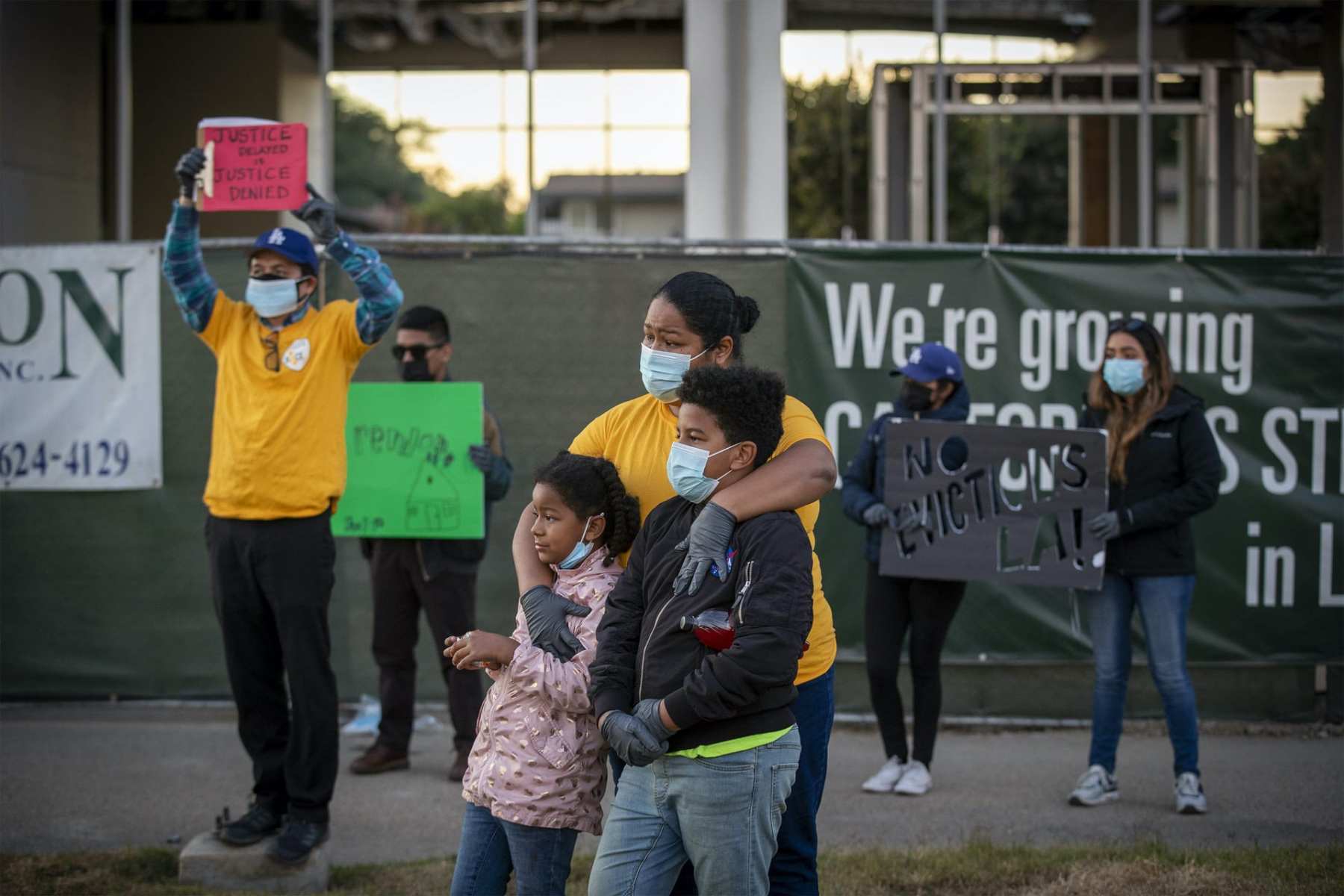Kelly Secovnie was supposed to have a good year.
An associate English professor at a community college in New York City, Secovnie was in the second half of an academic sabbatical to research how African literature is taught at community colleges. She had entered a key phase of that work in early March — widely sharing survey questionnaires that she had carefully designed — when cases of the coronavirus and hospitalizations emerged around the city.
“I was about to distribute them literally the day that the university was like, ‘We’re doing everything online,” she said. “And everything changed.”
Nearly overnight, Secovnie’s child care for her two children, then 5 and 7, disappeared. Her son’s elementary school closed, as did the local Y where her daughter attended preschool and her son was enrolled in an after-school program.
So Secovnie, whose husband died unexpectedly in 2016, kept her children home.
“It wasn’t an immediate crisis for me, because I was working from home already,” she recalled. “However, working from home just turned into not working from home and taking care of the children.”
Mothers have faced the brunt of child care responsibilities during the pandemic. They’ve reduced work hours or left the workforce altogether — in some cases, not by choice — to help their children with remote school learning or to address the logistics of sporadic daycare closures.
Then there are people like Secovnie, one of the roughly 13.6 million single parents in the country. During the pandemic, these parents, collectively raising over 21 million children (28 percent of all children in the United States), have even fewer options in a child care system that was already a hodgepodge of private and public care. The closure of schools and the switch to remote learning has complicated their ability to work.
“I think of school as a place where children go and get more than supervision. They learn, they develop, it’s good for their mental health,” said Kerri Raissian, an associate professor of public policy at the University of Connecticut. “It’s all kinds of things, but for a lot of single parents, it’s their daytime co-parent, and that’s missing.”
It remains unclear what the federal government will do to improve the lives of these parents — and by extension, their children. In late December, Congress approved additional funding to provide families with another round of one-time stimulus payments. The $900 billion package addresses paid leave, child care and food insecurity, but experts warn it won’t be enough for long-term relief.
And once a new administration is in office, a popular $775 billion caregiving plan proposed by President-elect Joe Biden may be contingent on whether Democrats can win a pair of U.S. Senate runoffs in early January.
Any relief coming for parents will carry additional significance for single parents. Before the pandemic, they faced higher rates of poverty than two-parent households. Among what the Pew Research Center describes as solo parents, mothers are almost twice as likely as fathers to be living below the poverty line (30 percent versus 17 percent). And women of color took some of the biggest hits in pandemic-induced job losses.
Despite these realities, unmarried parents spend more than twice as much on child care compared to married parents as a proportion of their family income.
“Unmarried parents were at a huge disadvantage for accessing affordable, high quality child care pre-pandemic,” said Laura Dallas McSorley, director of early childhood policy for the Center for American Progress, a left-leaning think tank. “With the additional constraints put on individual parents to be the backstop for both work and child care happening simultaneously, we know that’s putting undue pressure on unmarried parents to make hard choices that could jeopardize their future earnings in 2021 and beyond.”
That’s a dynamic that’s already playing out for Secovnie. It took her just one week into the pandemic to realize that she would need to put her long planned research on hold to prioritize taking care of her children. Emerging data shows she wasn’t alone; women in academia have reduced their research productivity, publishing less after the pandemic hit and family care needs fell disproportionately on them.
“It totally derailed my research project,” Secovnie said.
Vivien Tsou, a single mother of a three-year-old in Chicago, kept her child home when his daycare closed because of the pandemic.
Stuck in their apartment with no immediate family living in the state, Tsou simultaneously tried to take care of her toddler while doing her work as a community organizer for a nonprofit organization remotely. She called those initial weeks “impossible.” Her son was also confused about why he couldn’t spend time with his mom. He had internalized that being at home was family time. He interrupted her frequently as she tried to look at a glowing screen for more than a few minutes at a time.
“It was very chaotic, just trying to make it through every meeting, trying to figure out what to do,” she said.
Tsou has managed to find new child care for her son in recent months, but the home daycare is only available three days out of the work week. She watches her son the other two days while she works.
“I feel very stretched. It’s tough. I should feel grateful,” she reasoned, her voice cracking. “I’m able to do remote work. I’m able to have my son with me while I’m working. All of those things are incredible, lots of people don’t have that right now. And at the same time, I’m feeling bad about what’s going on, and feeling not very up to par. It’s just hard navigating those feelings.”
Julia Mahlstadt, a hair stylist in central Iowa, stayed home with her 8-, 6- and 2-year-old when the pandemic hit. Her two oldest were enrolled at a private school that closed, and her youngest attended a daycare on the campus that shut its doors.
She relied on unemployment, $200 from her parents and the $1,200 federal stimulus check to pay for rent and food for the first few weeks. She kept up with the $360-a-month private school tuition and daycare payments to hold onto their slots. It took her a long time to find quality care for her children before the pandemic, and she didn’t want to give that up.
Mahlstadt is scheduling some hair appointments now, but nothing compared to what she was doing before the pandemic. In the new year she is adding a second job: She will take a job at her daughter’s daycare, which will allow her to get a discount on tuition.
Mahlstadt said she is trying to spend as much time with her children when they’re not at school or daycare, which means not scheduling hair appointments outside of working hours. The experience of getting through the pandemic — the good and bad — has bonded them. Keeping that emotional pillar strong is important to Mahlstadt.
“Everything you do as a single mom, you do it as a team,” she said. “You move as one. At this point we’ve done all this hard work together and learned how to resist together. We don’t want to really leave each other either.”
Advocates have called for Congress to invest at least $50 billion to help providers stay open amid escalating operating costs; the latest stimulus package includes $10 billion for child care, which experts say will be quickly depleted. But Raissian said policymakers in 2021 need to take a holistic approach, including loans for small businesses to keep workers — parents — on payroll; expanding unemployment insurance, which helps single parents who are often the sole breadwinners of a family; and providing more rent relief and extending moratoriums on evictions (mothers, in particular Black women, are most likely to face housing insecurity).
“We know that any investments that we make in these families will have huge dividends in terms of preventing the adverse effects of childhood poverty,” she said, noting research that shows for every dollar spent on reducing childhood poverty, the country would save at least $7. “Like from a cost-benefit analysis, helping low-income families and single parents, this is a no brainer. And we should absolutely be doing that.”
This fall, Secovnie applied for emergency paid leave from her job, provided through a program available under emergency federal aid that Congress approved early during the pandemic. The program covered 60 percent of her pay, and she used sick time to further supplement her income. It allowed Secovnie to stay home to take care of her children.
Secovnie said she found the information on her own, then presented the request to her employer. The funding runs out at the end of December, and Secovnie will need to figure out what child care will look like in the new year. It could be a sitter who watches the kids while she’s in the next room teaching virtual classes. Her son is signed up for remote school, and she doesn’t have the option to switch him back to part-time, in-person classes.
“I don’t have a plan yet, so I’m hoping something happens in Washington,” she said. “… I’m not sure. I’m at an impasse. And just waiting to see what happens.”
For some single parents, the opportunities taken by the pandemic are hard to measure.
Beth Lykins, a mother of two in Ohio, had previously looked for quality child care for her sons, ages 6 and 5. Before the pandemic, she remembers touring a child care facility and crying afterward — she knew she wouldn’t be able to afford the monthly $2,000 bill.
Lykins eventually found a woman to watch her boys at a home daycare for a more affordable price, though she often wonders what a more structured day care setting could have provided for her youngest, who is autistic.
When the pandemic hit, Lykins began working remotely while watching her kids alone. In May, her company required her to return to the office (she works for a company that helps place nurses around the country). Her kids went to a new home daycare that became available.
In the fall, her oldest was set to start kindergarten and her youngest would enter preschool, giving her a break on child care costs. But both are enrolled in a form of online learning, and growing cases of COVID-19 in her community means that she’s had to keep paying for child care in order to make sure someone is watching her kids while she’s at work.
“This was supposed to be the year … I was finally going to get a break on our child care costs. I wanted to be in a place to buy a house this fall. And it’s like, none of that happened,” she said. “… And I feel like it’s such an important part of their development, right at this very moment. For them not to get that was heartbreaking, all over again.”
Raissian said creating a system that tries to safely reopen schools should be a priority for state and federal officials. That means having more conversations about whether teachers should get vaccinated early in order to switch back to in-person learning.
In 2021, Congress and the new administration in the White House have the chance to do something different, McSorley said. They have overwhelming evidence that the system wasn’t working before the pandemic and it’s only worsened now.
“Providers should be able to receive living wages, and parents should be able to access affordable care,” she said. “… I do feel like any time there’s a chance to say, ‘Maybe we can build things differently.”
For now, single mothers are managing the best they can — as are their kids. Recently, Tsou has noticed her son is trying to become more self-sufficient while they’re home together and she’s still working. He’ll grab his stool from the bathroom to wash his hands without calling for his mother. Or he’ll take the stool into the kitchen to reach water from the counter and grab prepared lunch from the refrigerator.
Tsou said while she’s proud of her son for trying to be respectful, it’s also a little sad.
“My son is trying to take care of himself, which should not be an expectation for a 3-year-old,” she said.






